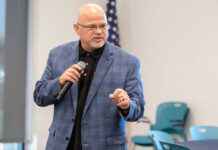November is an interesting month. Most of us vacillate between eager anticipation (Yaaay – Christmas is right round the corner!) and tight-lipped tension (there are only 54, 53, 52, 51…. shopping days ’til Christmas!) as we turn the calendar page over.
Some of us also start fasting in anticipation of Thanksgiving bounty while others do all of the above. Although I’m mostly in the latter category, I’d like to spend this month’s column talking about another November holiday that doesn’t generate nearly enough attention even though the special day I’m thinking of honors all those Americans who have provided us with the freedom to enjoy all of these other holidays.
I am, of course, talking about our veterans and the celebration of Veterans Day. For those not familiar with the origins of the day, the final armistice of World War I began on the 11th hour of the 11th day of the 11th month in the year 1918 and that date became synonymous with the end of WWI. One year later President Wilson proclaimed the day Armistice Day – a Presidential directive that was formalized by Congress with the Armistice Day Act of 1938. On June 1, 1954, Congressional leaders amended the Act and substituted the word “Veterans” for “Armistice” and declared the day would be a day to honor American veterans of all wars.
To commemorate the day and to honor all American veterans, an intrepid group of Casa Grande veterans (organized by Barney White) has organized a Veterans Day parade. Slated to get underway at 9:30 a.m. on Saturday, Nov. 10, the parade will move eastward on Cottonwood Lane, from Pinal Avenue to Casa Grande Avenue. There will be various military units and leading the parade will be the color guards from a variety of public safety agencies and other governmental organizations. Our Arizona veterans, including those who have served in Afghanistan, Iraq, World War II, Viet Nam, Korea, and other Cold War theaters are deserving of our respect and sincere acknowledgement of their willingness to sacrifice and their service to our country. That afternoon the Casa Grande Valley Historical Society will have a special showing of military paraphernalia in their museum (110 W. Florence Blvd.). And think of it – what could be more fun than a parade on a Saturday morning for a great cause?
Having invited everyone to the parade – which is the fun stuff connected with serving your country – it’s time to talk about the aftermath and consequences for those warriors and their families. Aside from the physical injuries and disabilities that our military veterans may bring back home from a tour of active duty, there are the invisible wounds of war. Today the medical community calls these psychological traumas PTSD or Post Traumatic Stress Disorder, and the total number of veterans from all eras treated by the VA for PTSD jumped 30% from 2003 to 2005.
In a recent study at the San Francisco VA Medical Center and the University of Southern California that reviewed the records of more than 100,000 veterans, the most common combination of diagnoses found was PTSD and depression. Veterans in regular military units have access to care system protocols that are well understood; however, service members in the Reserves and the National Guard face unique challenges with respect to the military health care system.
And let’s not forget the rest of the military family – those who stay behind when the unit is deployed. There are some 1.2 million children belonging to those currently on active military status. When you add the more than 650,000 children belonging to National Guard and Reserve troops, the total climbs to 1.85 million plus children with one or both parents serving their country. Some of us can imagine the trauma these families undergo when they learn that their soldier, Marine, airman or sailor won’t be coming home. Harder still are the stresses on families when news of their warrior’s safety is unknown or when they arrive back home damaged in spirit or otherwise suffering from PTSD.
But the military does its best to take care of its own. Today there are several family- focused organizations working to offer help to the veterans’ families. Blue Star Mothers are mothers who have now or have had children honorably serving in the military – it’s an organization that originated in the heat of WWII. Members support each other and their children, especially if a loved one is serving in harm’s way. And Gold Star families are recognized as having had a family member make the ultimate sacrifice for their country. Blue Star Mothers chapters meeting regularly are located in Phoenix and Tucson. The Marine Corps League Casa Grande, VFW Post 1677 and American Legion Post 8 are interested in assisting families of deployed troops by forming family support groups. For more information, contact [email protected] or [email protected].
Back to the topic of giving thanks: if you would like to send Christmas or holiday packages to a special American serving overseas, your deadline for parcel post mailings is November 13. There are other mailing deadlines after that, but each deadline closer to the holidays will be more expensive – when in doubt, mail early (and often !), even if you’re only mailing across the country. Above all, when you see a veteran, tell them “thank you” for their sacrifices, their service to our country and their willingness to stand in harm’s way for us and our right to enjoy the benefits of democracy.
Finally, as long as I’ve got you thinking about parades, let me remind you about Casa Grande’s very own Electric Light Parade. With enough entries to put Phoenix’s parade to shame, this year’s event will take place on Saturday, Dec. 1. Just as soon as city officials light the City’s tree in Peart Park (approximately 6 p.m.), the parade will get underway. See you at the parade!
Have an opinion you’d like to share with Maricopa? Please email it (500-750 words) and any applicable photos to [email protected] for consideration. For more details, click here.















![Alleged car thief released without charges Phoenix police stop a stolen vehicle on April 20, 2024. [Facebook]](https://www.inmaricopa.com/wp-content/uploads/2024/04/IMG_5040-100x70.jpg)
![Locals find zen with Earth Day drum circle Lizz Fiedorczyk instructs a drum circle at Maricopa Community Center April 22, 2024. [Brian Petersheim Jr.]](https://www.inmaricopa.com/wp-content/uploads/2024/04/PJ_3922-Enhanced-NR-100x70.jpg)